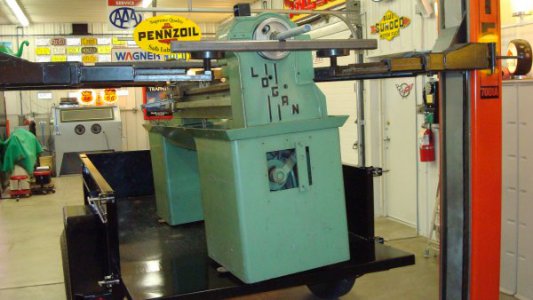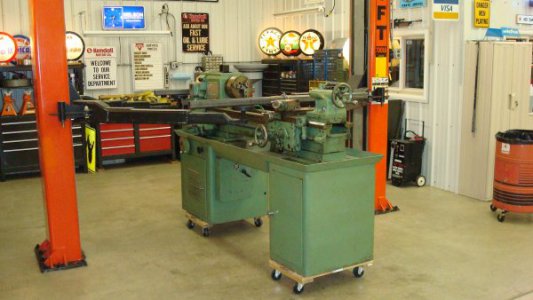-
Welcome back Guest! Did you know you can mentor other members here at H-M? If not, please check out our Relaunch of Hobby Machinist Mentoring Program!
You are using an out of date browser. It may not display this or other websites correctly.
You should upgrade or use an alternative browser.
You should upgrade or use an alternative browser.
How Did You Handle Getting Your Lathe Home?
- Thread starter Holescreek
- Start date
Had my lathe delivered to my shop doorway a few weeks ago, I have a fork lift so unloading off the truck was easy. Dropped both the pallets it was shipped on down onto my welding table which has a 1" plate top and is on heavy duty solid castors
Stripped it down, cleaned it up, oiled it, contacted Grizzly for the missing tools and damaged control panel plate, then I strapped it up and used my trusty Harbor Freight cherry picker to take it into my shops 'clean room' and lift it onto the bench.
Dear old wifey steered while I pushed/pulled, then she delicately lowered it onto straight onto the mounting bolts. Pretty good control of the lowering valve on the cherry picker too, a slow decent that was barely perceivable
Now to level it and start making chips!
Stripped it down, cleaned it up, oiled it, contacted Grizzly for the missing tools and damaged control panel plate, then I strapped it up and used my trusty Harbor Freight cherry picker to take it into my shops 'clean room' and lift it onto the bench.
Dear old wifey steered while I pushed/pulled, then she delicately lowered it onto straight onto the mounting bolts. Pretty good control of the lowering valve on the cherry picker too, a slow decent that was barely perceivable
Now to level it and start making chips!
- Joined
- Apr 12, 2011
- Messages
- 3,571
- Joined
- Apr 12, 2011
- Messages
- 3,571
Randy, you definitely used the appropriate tools. If my lathe had been any bigger, I seriously doubt the pickumup and the 1-ton engine hoist I had would have done the job.
Ah but, John, you had help.
 Yeah, I sometimes take my equipment to the limit as well. In this case I was well with in the safety limits. It is good see you got it all home safe and sound.
Yeah, I sometimes take my equipment to the limit as well. In this case I was well with in the safety limits. It is good see you got it all home safe and sound.I used a lift-bed trailer to bring my G0907 home, with the aid of two good friends. I cut rigid metallic conduit into 2.5' and 5' sections and used them as rollers to move the lathe into position. I designed a 4' wide cradle dolly out of 2x6s, lag screwed together with 8" lag screws, in CAD, and then built it partly at home before I left but mostly on site around the lathe. I built up the headstock end first and left the tailstock end open to slide the dolly into place. I used 4 foot sections of 1" hot-roll for lift bars, and an engine hoist and a sling around the lift bars to lift it just high enough to get onto the cradle and bolt down. After the headstock end was bolted down, it was stable and I could lift the tailstock end without worrying as much about tipping. I moved the tailstock supports underneath, screwed them together with lag screws, and set the dolly down on 5' rollers. With a 51" base (48" inside longitudinal beams) it exhibited no tendency to tip over.
I loaded the lathe headstock-forward to get the right balance in the trailer.
I winched the cradle dolly on the pipe onto the trailer, running it on the rollers and leaving the rollers in place for transport. The trailer had a 2" receiver at the head that I used to mount a strap winch to pull it onto the deck; if I had it to do over again I would use a cable winch instead. I used four high-capacity ratchet straps to tie down the lathe; I used the lift bars fore and aft and tied each bar forward and backward. (Here some 2x4s alongside it obscure the dolly, sorry.)
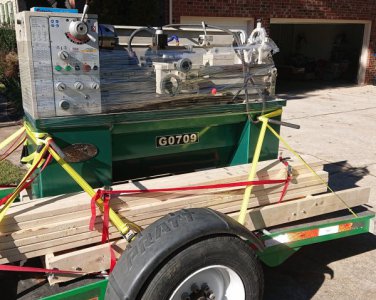
When I removed the lathe from the trailer, I rolled it most of the way off, then lifted the headstock end with the trailer and screwed cheap wheels to the frame near the center of gravity, about 2' from the headstock end. (If I were doing it over, I would use 5/8" rod rather than 5/8" lag screws; one of the lag screws bent while I pulled it.) Then I set it on the ground, used lag screws to fasten a 2x4 tongue to my cradle dolly (now itself a trailer!) and pulled it with my lawn tractor into my shop.
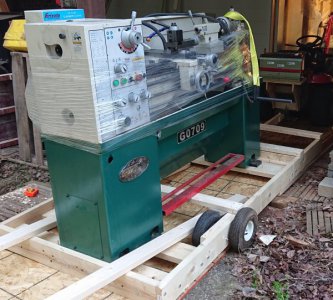
The 2x4s sticking out the back were levers to help it up a slight ramp over the doorway into the shop.
In my shop, I used the engine hoist to put utility dollies under each corner and lock them in place with screws, then removed the wheels (not a trailer any more!) so they didn't interfere. I rolled the lathe into place and removed the cradle sides. Then starting at the tailstock end, I lifted it off the cradle ends, removed the cradle ends, installed leveling feet, and lowered it in place; then did the same under the headstock. Removing the chip catcher temporarily made it easier to use the engine hoist to lift the tailstock. Adjusted the feet to make it reasonably level to start with.
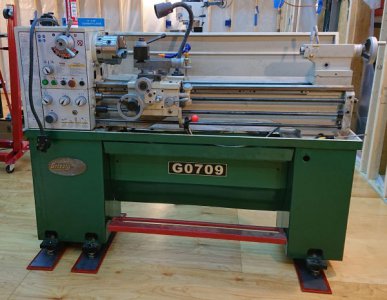
(Yes, there will be fire-resistant material in front of it for hot chips when it's running.) The feet are 4"x1" bars drilled and tapped for leveling screws, which are sitting on .325" x 6" load spreader bars on the shop floor, which wasn't originally intended to hole a machine this big. It's carefully placed for appropriate support though.
The 4' A36 hot-roll 1" round lift bar in the headstock end bent. That was impressive!
I loaded the lathe headstock-forward to get the right balance in the trailer.
I winched the cradle dolly on the pipe onto the trailer, running it on the rollers and leaving the rollers in place for transport. The trailer had a 2" receiver at the head that I used to mount a strap winch to pull it onto the deck; if I had it to do over again I would use a cable winch instead. I used four high-capacity ratchet straps to tie down the lathe; I used the lift bars fore and aft and tied each bar forward and backward. (Here some 2x4s alongside it obscure the dolly, sorry.)

When I removed the lathe from the trailer, I rolled it most of the way off, then lifted the headstock end with the trailer and screwed cheap wheels to the frame near the center of gravity, about 2' from the headstock end. (If I were doing it over, I would use 5/8" rod rather than 5/8" lag screws; one of the lag screws bent while I pulled it.) Then I set it on the ground, used lag screws to fasten a 2x4 tongue to my cradle dolly (now itself a trailer!) and pulled it with my lawn tractor into my shop.

The 2x4s sticking out the back were levers to help it up a slight ramp over the doorway into the shop.
In my shop, I used the engine hoist to put utility dollies under each corner and lock them in place with screws, then removed the wheels (not a trailer any more!) so they didn't interfere. I rolled the lathe into place and removed the cradle sides. Then starting at the tailstock end, I lifted it off the cradle ends, removed the cradle ends, installed leveling feet, and lowered it in place; then did the same under the headstock. Removing the chip catcher temporarily made it easier to use the engine hoist to lift the tailstock. Adjusted the feet to make it reasonably level to start with.

(Yes, there will be fire-resistant material in front of it for hot chips when it's running.) The feet are 4"x1" bars drilled and tapped for leveling screws, which are sitting on .325" x 6" load spreader bars on the shop floor, which wasn't originally intended to hole a machine this big. It's carefully placed for appropriate support though.
The 4' A36 hot-roll 1" round lift bar in the headstock end bent. That was impressive!
- Joined
- Nov 23, 2017
- Messages
- 1,191
- Joined
- Jan 2, 2016
- Messages
- 1,953
I use two 10K winches, one to drag the machine off the trailer, and down the ramps, and the other to keep it from going down too fast. So far has worked great for everything I moved. For the Southbend 16", I braced the legs with two 4x4's cut to fit tight between the legs and the base, so there would not be flex. I tried using the engine hoist, with the wells index, but did not do well with the chain, and when it was in the air, waiting on the trailer to be pulled forward, the chains decided to slide around, and gave both of us a good scare, and tested the engine hoist. 2nd pic.
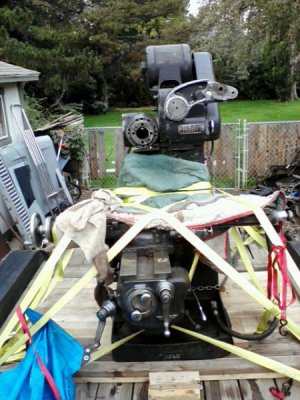
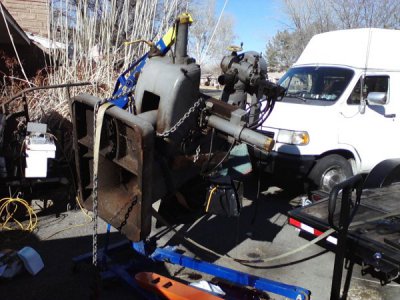
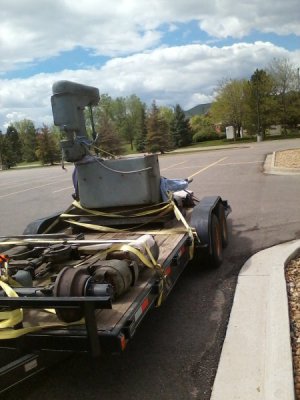



- Joined
- Jul 2, 2014
- Messages
- 7,594
Yikes on the scare...

